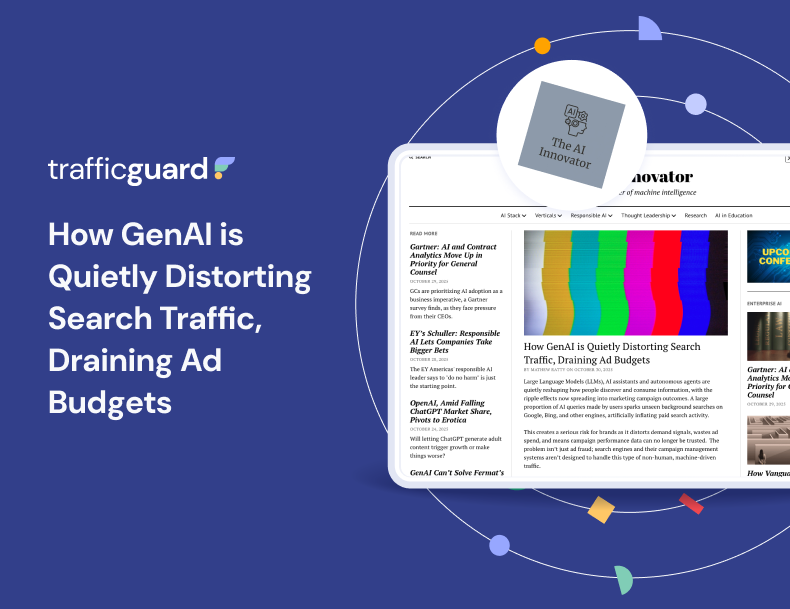Ad Fraud in a Challenging Economy: Optimizing Digital Advertising to Deliver Real-World Results

As consumer spending dips, retailers and ecommerce businesses are facing a perfect storm that is impacting their digital advertising ROI. They are being challenged with growing ad fraud in digital campaigns and a slowing economy. The result is a growing need to optimise digital campaigns to ensure they are reaching the right consumers and delivering legitimate traffic to their websites.
According to Statista, retail ecommerce sales are predicted to reach $8.1 trillion by 2026. This makes the industry an incredibly tempting target for fraudsters. At the same time, the UK Office for National Statistics notes that approximately two-thirds of adults in Great Britain are spending less on non-essentials because of the rising cost of living. The survey also revealed that half were shopping around more.
More than ever, it has become crucial that digital campaigns deliver real-world results. Google’s AI-based campaigns offer a number of benefits to retailers, from increased reach to relieving workloads by leveraging AI to automate processes. However, fraudsters are always developing new methods to exploit and manipulate businesses and generate fake engagement through invalid traffic (IVT) and ad fraud. IVT causes massive disruption to campaigns, producing unreliable results that impact budgets.
The threat of IVT is not one that can be ignored, and the harm it can do to budgets is significant. This means businesses need to focus on ensuring the quality of their traffic over quantity to minimise the risk of potential losses.
It is possible for organisations to still obtain the highest value from their digital campaigns without having to reduce budgets. By analysing and optimising campaigns through the removal of IVT, organisations can increase ROI and guarantee long-term revenue.
AI, Algorithms, and New Risks
Google’s AI-based Performance Max (PMax) campaigns are capable of increasing marketing efficiency, but there are flaws with the AI that threat actors can exploit. The algorithm used by these platforms views any engagement as positive and from a genuine user. The issue arises when threat actors create fraudulent activity, as the algorithm can’t distinguish fake traffic from real. This typically goes unnoticed by organisations, leaving campaign data compromised without anyone realising.
Marketers in this space are beholden to the decisions of algorithms they do not fully understand or control, making it a huge challenge to align their marketing efforts with the best interests of their customers.
Retailers stand to lose out on potential profit and customers as the fraudulent traffic generated by IVT causes AI to optimise toward this instead of legitimate sources that could lead to conversions.
While this continues, Google AI-based campaigns are holding retailers back instead of driving marketing efficiency as intended. By implementing tools and solutions to compensate for AI vulnerabilities, businesses can effectively obtain the full value from their digital campaigns.
Taking a Proactive Stance
The data obtained from a digital campaign is critical for making future business decisions. This means it needs to be as accurate as possible. If not, retailers risk wasting their investment on the wrong sources or irrelevant audiences.
As it stands, retailers are unable to make the most of their digital campaigns due to the interference of fraudsters. This makes the systems running the campaigns more of a hindrance than a help. This doesn’t have to be the case, however. To optimise their Google AI-based campaigns and maximise ROI, businesses need to take preventative measures.
The most important step retailers can take is to thoroughly analyse their incoming traffic. This is made possible by implementing analytic and reporting tools to identify any fraudulent activity. These tools leverage machine learning (ML) to look for irregular spikes or patterns in traffic, which can then be identified and dealt with accordingly.
Another potential action that organisations can take is to develop and build the right audience signals. These are tools that allow organisations to identify and target the groups of users that are most likely to convert based on their demographics. This allows retailers to design future campaigns that are more specific to their target audience, increasing the chance of conversion.
Making the Most of Your Campaigns
Fraudsters will continue to evolve their tactics to exploit growth in the digital market. Left unchecked, the damage to budgets will be substantial, affecting not only the campaign they’re infiltrating but future ones as well.
This doesn’t have to be the case. By actively tackling fraudulent activity, organisations can mitigate harm to their campaigns and utilise AI ad platforms to their full potential in the retail market.
Read more 👉 here
Get started - it's free
You can set up a TrafficGuard account in minutes, so we’ll be protecting your campaigns before you can say ‘sky-high ROI’.
At TrafficGuard, we’re committed to providing full visibility, real-time protection, and control over every click before it costs you. Our team of experts leads the way in ad fraud prevention, offering in-depth insights and innovative solutions to ensure your advertising spend delivers genuine value. We’re dedicated to helping you optimise ad performance, safeguard your ROI, and navigate the complexities of the digital advertising landscape.
Subscribe
Subscribe now to get all the latest news and insights on digital advertising, machine learning and ad fraud.







